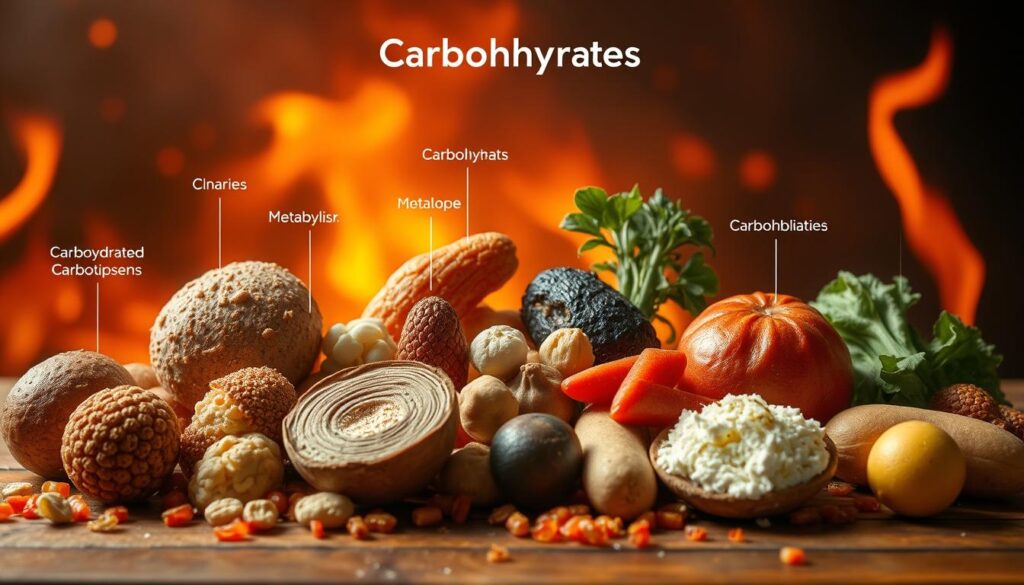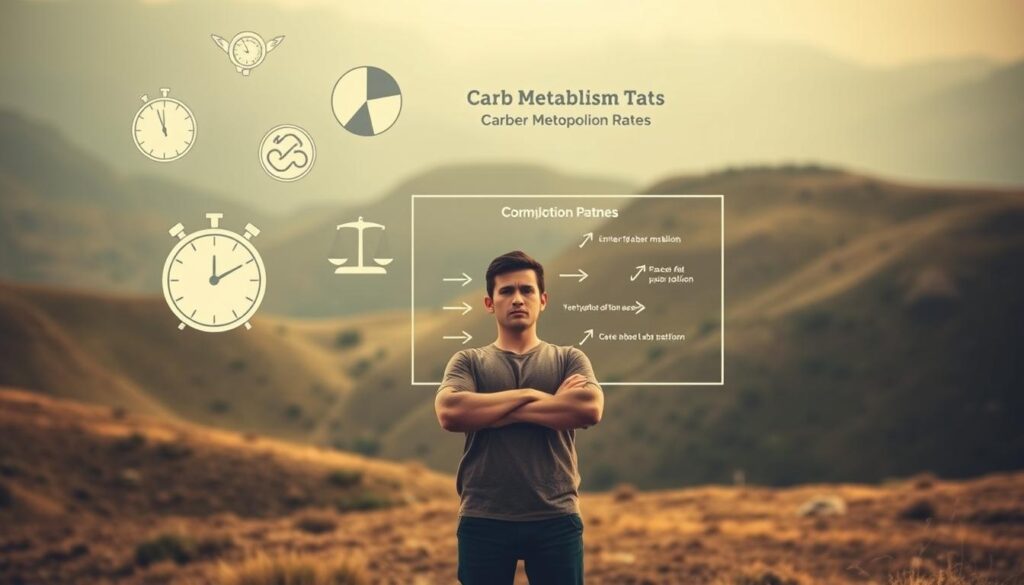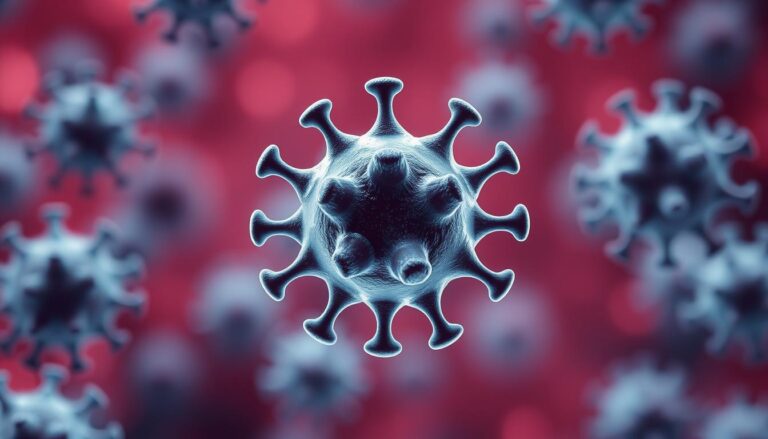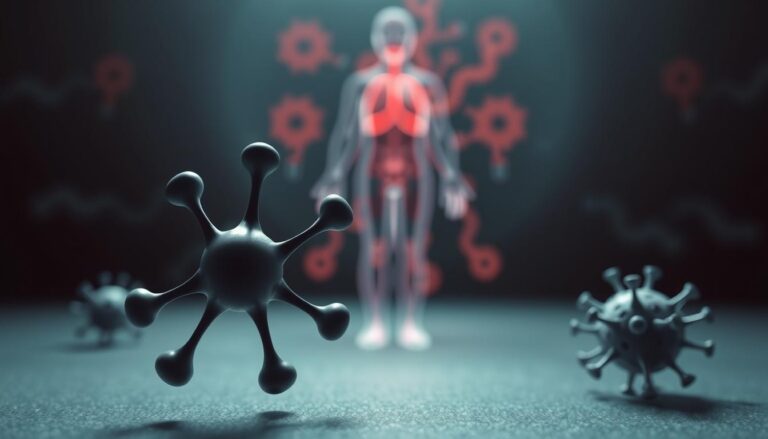Ever wondered how long it takes your body to burn carbs after eating a muffin or drinking a smoothie? The answer might change what you think about carb burning time and weight loss. Carbs, one of the main nutrients, give 4 calories per gram and power our brains and workouts. But, myths about how fast they’re used are common.
This article dives into the science of carb metabolism rate. It covers how carbs are stored in muscles and how exercise changes how we use glucose. What happens when you eat only 50 grams of carbs a day? How do workouts affect glucose use? The answers show why some diets work and why timing is key.
Key Takeaways
- Carb metabolism timelines depend on type, quantity, and physical activity levels.
- Keto diets trigger water loss as glycogen stores deplete, losing 3 grams of water per gram of glycogen.
- High-intensity exercise prioritizes glucose, while low-intensity burns more fat calories.
- Individual carb burning time varies due to age, insulin sensitivity, and muscle mass.
- Understanding glycogen depletion explains initial keto weight loss patterns.
Understanding Carbohydrate Metabolism
How fast your body burns carbs depends on how it breaks them down. This starts in the digestive system. Here, enzymes turn carbs into glucose, our main energy source. We’ll look at how carbs fuel our bodies.
The Science Behind How Your Body Processes Carbs
Carbs start in the mouth, where enzymes break them down. In the small intestine, more enzymes turn them into glucose. This glucose goes into the blood, making insulin release.
The liver keeps blood sugar levels steady by storing glucose as glycogen. When we’re active, muscles use glycogen for energy.
Types of Carbohydrates and Their Metabolic Pathways
- Simple carbs (like sugar and fruit juice) digest fast, raising blood sugar quickly. Their short structure means they’re absorbed quickly, affecting how long carbs burn.
- Complex carbs (like oats and quinoa) take longer to digest, releasing glucose slowly. Their structure slows absorption, giving us energy longer.
Complex carbs have lower glycemic indices. This means they’re metabolized slower than simple carbs.
Role of Insulin in Carb Processing
Insulin is key in regulating glucose. It helps cells use glucose for energy or store it. When glucose is low, the liver makes glucose from other sources.
Good insulin function keeps energy use balanced. This is important to avoid storing fat from too much carb intake.
How Long Does It Take to Burn Off Carbs?
How long it takes to burn carbs varies based on several factors. Let’s explore how the body processes carbs and what affects the time it takes.

Immediate Carb Burning: The First 4 Hours
Carbs start turning into glucose 30 minutes after eating. The first 4 hours see a quick insulin release and glucose use by muscles and the liver. Any leftover carbs get stored as glycogen.
Doing high-intensity exercise during this time can speed up glucose use by 30–50%, studies show.
Complete Carb Processing Timeline
Here’s a simplified timeline for carb metabolism:
| Stage | Duration | Process |
|---|---|---|
| Initial Digestion | 1–2 hours | Carbs broken into glucose in the gut |
| Insulin Response | 30–60 mins post-meal | Glucose enters cells for energy or storage |
| Glycogen Storage | 4–24 hours | Unused glucose converts to glycogen in liver/muscles |
| Long-Term Utilization | 1–3 days | Stored glycogen used during fasting or exercise |
Individual Variations in Carb Metabolism Rate
- Genetics: Some people store glycogen faster due to genetic differences.
- Age: Older adults might metabolize carbs slower, making it take longer to burn carbs.
- Activity Level: Those who do resistance training use up glycogen stores faster than those who are less active.
For instance, a 2022 study in the International Journal of Obesity found that high-intensity interval training (HIIT) can cut down carb burning time by up to 25% compared to resting.
Factors That Affect Your Carb Burning Duration
Carb burning duration and metabolism rate are influenced by many factors. Exercise intensity is key. Low-intensity workouts use more fat, saving carbs. But, high-intensity activities like sprinting use more carbs.
- Exercise Intensity: Low-to-moderate activity saves carb stores. High-intensity workouts quickly use up glycogen.
- Training Adaptations: People who are aerobically trained burn more fat. This means they use carbs slower during long workouts.
- Nutrition Timing: Eating carbs before working out boosts blood sugar. This increases carb burning.
- Body Composition: More muscle means more glycogen storage. This helps keep carbs available during exercise.
- Hormonal Status: Stress hormones like cortisol can lower insulin. This changes how carbs are metabolized during and after exercise.
| Factor | Impact on Carb Burning Duration |
|---|---|
| Exercise Intensity | Inversely proportional to carb reliance |
| Gender | Women oxidize more fat at submaximal efforts |
| Dietary Fiber | Slows glucose absorption, delaying carb oxidation |
| Sleep Deprivation | Reduces insulin sensitivity, altering carb metabolism rate |
| Hydration Status | Dehydration impairs glycogen utilization efficiency |
Everyone is different, so plans need to be tailored. Endurance athletes might eat more carbs to keep their metabolism up. Those trying to lose fat might do low-intensity workouts to burn carbs longer. Knowing these factors helps create better exercise and nutrition plans for your goals.
The Relationship Between Carb Types and Burning Efficiency
Carbohydrate structure and composition affect how well the body uses them. This section looks at how carb types impact energy release, digestion speed, and metabolic outcomes.
Simple vs. Complex Carbs: Breakdown Speed Differences
- Simple carbs (e.g., fruits, white bread) break down fast, giving quick energy but short-lasting fullness.
- Complex carbs (e.g., quinoa, sweet potatoes) digest slower, providing steady energy and helping burn carbs longer.

Fiber Content and Its Impact on Carb Burning Time
Fiber changes how long carbs take to burn by affecting digestion. Soluble fiber, like in oats, slows digestion, making energy last longer. This is because it delays glucose absorption, reducing blood sugar spikes and extending metabolic time.
Glycemic Index and Carb Metabolism
High-GI foods (e.g., white rice, candy) burn carbs quickly, causing insulin spikes. Low G.I. foods (e.g., lentils, apples) digest slowly, keeping energy stable. Mixing high-GI carbs with fats or protein can balance energy use.
Physical Activity and Carb Elimination Process
Physical activity changes how our body handles carbs. Exercise speeds up the carb elimination process and improves energy use. Whether it’s short bursts or long workouts, it affects how carbs are used and stored.
Muscle contractions during exercise start breaking down glycogen into glucose. High-intensity workouts use more carbs, while long activities use more fat. Key strategies include:
- Phased carb intake: Eat more carbs at the start of training, then reduce to adapt to fat.
- Slow-release carbs like UCAN’s unique formula keep energy steady, helping with endurance.
- 55-65% of daily calories from carbs for athletes balances performance and recovery.
“Adjusting my carb timing phases improved my marathon stamina and recovery.”
After exercise, insulin sensitivity increases, helping muscles take in glucose. This “metabolic window” is key for glycogen restoration. But too many carbs can slow down fat adaptation. To burn carbs efficiently:
- Eat carbs within 30 minutes after working out for best glycogen resynthesis.
- Don’t skip carbs for high-intensity training, as they fuel anaerobic activities.
- Get advice from sports nutritionists to match carb intake to your activity level.
Keeping this balance helps maintain energy and avoid fatigue, matching metabolic changes over time.
Best Exercises for Burning Carbs Efficiently
High-intensity workouts use fast-twitch muscles that burn glycogen fast. To burn carbs efficiently, choose activities that keep your heart rate high. Studies in the Journal of Sports Science and Medicine show HIIT is better than steady cardio for glycogen use.
- High-Intensity Interval Training (HIIT): Mix 30-second sprints with 1-minute breaks. This quickly uses up glycogen, making carbs a priority.
- Sprint Intervals: Quick runs or bike rides followed by rest. They use stored carbs for energy.
- Resistance Circuits: Do compound lifts like squats and deadlifts with little rest. This boosts insulin sensitivity, helping carbs get stored better.
- Cycling Sprints: 30-second all-out bike efforts with 4-minute breaks. It’s great for carb use in muscles.
“Eating carbs after exercise helps refill muscle glycogen best when done within 30 minutes,” Journal of Applied Physiology says.
For best results, match these workouts with the right carb intake timing. A post-workout shake with whey protein, creatine, and fruits like mango and banana helps recovery and carb use. Avoid low-intensity activities like walking for carb burning. Regular use of these methods improves how well your body burns carbs efficiently during and after exercise.
Metabolic Factors That Influence Carb Burning Time
Three main factors affect how fast you burn carbs: basal metabolic rate, hormonal balance, and age. These elements work together to determine how well your body turns carbs into energy.
Basal Metabolic Rate and Carbohydrate Processing
Basal metabolic rate (BMR) is the energy you use when you’re not moving. A higher BMR means you burn carbs faster, thanks to more muscle mass. Muscle burns more calories than fat, which helps increase carb metabolism rate.
For example, athletes have a higher BMR. This is because their muscles are more active, breaking down carbs quicker. This is due to better mitochondria and enzyme function.
Hormonal Influences on Carb Metabolism
Hormones like insulin, glucagon, cortisol, and thyroid hormones control how your body uses glucose. Problems with these hormones, like insulin resistance, can slow down carb burning time. Here’s how:
- Insulin helps move glucose into cells, but resistance slows this down.
- Glucagon releases glycogen when you’re fasting or exercising.
- Thyroid hormones affect your metabolic rate, influencing carb use.
Age-Related Changes in Carb Processing
As you get older, your carb metabolism rate slows down. This is because you lose muscle and your body becomes less sensitive to insulin. For example, older adults, like postmenopausal women, may have different hormone levels. This can slow down glycogen breakdown compared to younger people.
Weight Loss and Carbs: Finding the Right Balance
Managing weight loss and carbs means matching what you eat to your body’s needs. Studies show the best ways involve timing, quality, and amount. This helps with carb burning time and keeps energy levels up.
“Timing of carbohydrate intake influences fat metabolism. Studies show morning carb consumption aligns with peak metabolic activity, boosting carb burning time efficiency.”
Carb cycling is a proven method. It involves:
- Switching between high, moderate, and low-carb days
- Pairing high-carb days with low-fat meals and lots of protein
- Adjusting cycles based on activity levels and goals
| Goal | Carb Range (2,000-calorie diet) | Key Focus |
|---|---|---|
| Weight Loss | 100–150g | Complex carbs (oats, legumes) for satiety and glycemic control |
| Maintenance | 225–325g | Balance with fiber-rich options and portion management |
| Active Individuals | 250–350g | Timing carbs around workouts to optimize energy use |
Combining carbs with fiber slows digestion. This extends carb burning time and lowers blood sugar. For instance, eating 40–50g of carbs per meal keeps energy steady and prevents overeating. Always eat at least 130g of carbs daily to support brain health.
Science backs up tailored plans. Focus on whole foods, track what you eat, and get advice from healthcare experts for a plan that fits you.
Strategies to Accelerate Carb Burning
To boost carb metabolism rate, you need to make smart changes in your diet, timing, and supplements. There are proven ways to match your metabolism with your energy needs. These methods help your body use carbs more efficiently.
Nutritional Approaches to Enhance Metabolism
Eating carbs with protein helps keep insulin levels stable and improves how your body handles sugar. Foods like green tea or chili peppers can also kickstart your metabolism. Drinking enough water is key for breaking down carbs.
For a 2,000 calorie diet, try different carb levels. High-carb days have 225g, moderate days have 130g, and low-carb days have 75g. This mix helps balance your energy and fat use.
Timing Your Meals for Optimal Carb Processing
- Eat carbs in the morning to match your body’s natural rhythms and improve mitochondrial function.
- Try intermittent fasting for up to 16 hours to help your body burn fat. But be careful not to fast too long.
- After working out, eat carbs within 30 minutes to help your body recover and stay flexible.
Supplements That May Affect Carb Metabolism
Some supplements might help with carb processing:
- Chromium helps your body use insulin better (200-1,000mcg/day).
- Berberine (500-1,500mg/day) could improve how you take in glucose.
- Cinnamon extract (1-6g/day) has been studied for controlling blood sugar.
Always talk to a healthcare provider before taking any supplements. This is to make sure they won’t interact with other medications.
Common Myths About Carb Burning Duration
It’s important to know the truth about carbs. Many myths about carbs are not backed by science. This section will look at these myths and share facts.
Debunking Popular Misconceptions
“Carbohydrates metabolism involves complex biological processes that defy oversimplified myths.” – American Diabetes Association
- Myth: “Nighttime carbs convert directly to fat. Fact: Timing matters less than overall calorie balance, per metabolic research.
- Myth: All carbs burn at the same rate. Fact: Carb metabolism rate varies based on type, fiber content, and meal composition.
- Myth: Eliminating carbs for weight loss. Fact: The Dietary Guidelines for Americans 2010 recommend 45–65% of daily calories from carbs for most adults.
Science-Based Insights
| Myth | Scientific Evidence |
|---|---|
| “Low-carb diets eliminate fat storage” | Initial weight loss often reflects water loss, not fat (Journal of the Academy of Nutrition and Dietetics). |
| “Glycemic index alone predicts carb effects” | GI ignores food combinations; context determines metabolic response (Journal of Nutrition, 2019). |

How long carbs burn depends on many factors. These include how active you are and how well your body uses insulin. Eating whole grains, legumes, and starchy veggies helps your body use carbs better. Studies show that foods high in fiber help you feel full and control blood sugar, proving that not all carbs are bad.
Personalized Approaches to Understanding Your Carb Metabolism
Getting to know your carb metabolism rate means creating plans just for you. Things like age, how active you are, and what you want to achieve in health matter. Tools like continuous glucose monitors (CGMs) show how carbs affect your blood sugar right away. Labs can also test how your body uses energy and insulin, giving you useful information.
- Carb cycling: Alternating high- and low-carb days to maintain metabolic flexibility
- Timing carb intake around exercise to optimize glycogen storage
- Adjusting carb quality (e.g., choosing fibrous vegetables over refined grains)
| High-Carb Day Goals | Low-Carb Day Goals |
|---|---|
| Replenish glycogen stores (+40-150g carbs) | Promote fat oxidation (30-50g net carbs) |
| Support muscle recovery post-workout | Improve insulin sensitivity |
“Metabolic flexibility prevents the body from becoming dependent on one energy source,” note experts at the American Diabetes Association.
People with insulin resistance might need fewer carbs. Athletes should match their carb intake with their workout intensity. Keeping track regularly helps make changes as needed. Working with experts ensures your plan stays up-to-date with your health. Always talk to a doctor before making big changes to your diet.
Conclusion
Understanding your metabolism is key to losing weight and managing carbs. How your body handles carbs changes based on exercise, fiber, and hormones. High-intensity workouts like cycling or HIIT are great for burning carbs.
These activities use glycogen stores well during long workouts. For example, a 200W cycling session burns about 720 kcal every hour. It uses both glycogen and fat for energy.
Choosing the right carbs is important. Foods high in fiber help your heart and control blood sugar. To lose weight, focus on eating nutrient-dense carbs and keep a calorie deficit.
When cutting carbs, watch your insulin and protein intake. This helps avoid ketosis problems. Getting personalized advice from metabolic tests and experts is vital for a good plan.
It’s important to watch for signs of glycogen depletion, like a rising heart rate. Adding fat oxidation training can also boost endurance. Eating whole foods and keeping a balanced diet helps your metabolism stay flexible.
While exercise intensity is important, how you react to low-carb diets can vary. Always talk to a healthcare provider before making big changes to your diet or exercise routine. This ensures your health goals are met safely.
FAQ
What is carb burning time, and why is it important?
Carb burning time is how long it takes for the body to use carbs after eating. It’s key for those who want to eat right and exercise well.
What factors influence the rate of carbohydrate metabolism?
Many things affect how fast carbs are broken down. This includes the carb type, how your body works, how active you are, hormones, and your health.
How does the body process carbohydrates after consumption?
After eating carbs, they turn into glucose in the stomach. This glucose is then absorbed and carried by the blood. How fast this happens depends on the carb type and other nutrients.
What is the difference between simple and complex carbohydrates regarding metabolism?
Simple carbs are digested fast, causing quick blood sugar spikes. Complex carbs take longer to digest, giving energy over a longer time.
How does insulin function in carbohydrate metabolism?
Insulin helps control carb use. It helps cells take in glucose, deciding if carbs are used right away or stored.
How long does it take to burn off carbs after a meal?
Carbs are processed quickly, usually in the first four hours after eating. Blood sugar spikes happen 30-60 minutes after, followed by insulin and glucose uptake.
What are the most effective exercises for burning carbs?
High-intensity workouts like HIIT, sprinting, and circuit training burn carbs best. They use anaerobic pathways.
How do age and hormonal factors affect carb metabolism?
As we age, insulin sensitivity and hormone balance change. This can slow down carb processing and affect how we use carbs.
What role does fiber play in carbohydrate metabolism?
Fiber slows carb digestion, keeping blood sugar stable and making us feel full. Soluble and insoluble fibers affect carb processing and absorption.
What common myths exist about carb burning duration?
Myths say carbs eaten at night turn to fat or that cutting carbs is key for weight loss. But, it’s really about calorie balance that matters.
How can I personalize my carbohydrate intake for weight management?
You can find your carb tolerance with glucose monitoring and metabolic tests. Adjusting carbs based on your activity, health, and metabolism helps with weight control.
Are there supplements that can aid in carb metabolism?
Supplements like chromium and alpha-lipoic acid might help with carb use. But, talk to a doctor first, as everyone reacts differently.





